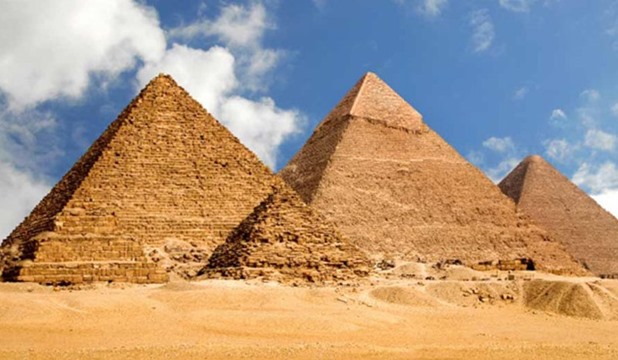The Pharaonic era in Egyptian history extends for about three thousand years, from 3200 BC until Alexander the Great entered Egypt in 323 BC.
During the Pharaonic era, Egypt witnessed many stages of renaissance and progress that left a huge legacy of manifestations and effects of civilization, architecture, science and arts.
Historians divide the Pharaonic era in the history of Egypt into three successive sections:
– The old state.
– The Middle Kingdom.
– The modern state.
Historians also divide this era into thirty ruling families divided into these three stages of Egyptian history.
The Ancient Era ( Dynasties 1 and 2):
King Menes is credited with achieving the political unity of Egypt around the year 3200 BC. M., and he was able to establish the first ruling family in the history of Pharaonic Egypt. Menes wanted to secure the unity of the country, so he established a city near the head of the Delta that was later named “Memphis.” This unity was an important factor in the renaissance of Egypt in all aspects of life.
Old Kingdom (Dynasties 3 to 6):
The era of this state is considered the period of Egypt’s youth, and it was characterized by stability, security, and peace, which facilitated its economic, cultural, and artistic progress. The ruling brigade of the kings of the Old Kingdom, who built the pyramids, was convened around 2800 BC after the throne of the country was transferred to Memphis at the hands of Pharaoh Djoser. He is the owner of the oldest known pyramid, which is the Step Pyramid at Saqqara. Egypt’s civilization flourished during the days of this state, and there is no clearer evidence of that than the huge pyramids of Giza of Kings Khufu, Khafre, and Menkaure.
The First Middle Ages (Dynasties 7 to 10):
This era began around 2200 BC. When the reins of power escaped from the hands of the Pharaoh, Mentuhotep II was able to unify the country again.
Middle Kingdom (Dynasties 11, 12):
After Mentuhotep II, Prince of Thebes, succeeded in about the year 2065 BC. In order to reunify the country, he established a strong government that succeeded in consolidating the regime and establishing security, which helped the country’s economic recovery and the advancement of arts and architecture. Then, he began in the year 2000 BC. The reign of a great man, Amenemhat I, who is most credited with building the renaissance that emerged during the Middle Kingdom.
The kings and queens of the Twelfth Dynasty gained international fame in the fields of politics, war, culture, civilization, and religion, such as “Ahmose,” the hero of liberation, “Amenhotep I,” the just man who issued a law prohibiting forced labor and setting fair standards for wages and incentives, and “Thutmose I,” the warrior who expanded the Egyptian borders. North and south, he spread education and expanded the opening of mines and the mining industry. “Thutmose II” and “Thutmose III,” the emperor with outstanding military genius and the first great conqueror in the history of the world, and “Thutmose IV,” the diplomat who was the first to be interested in codifying and recording international treaties, and “Amenhotep III,” the richest king in the ancient world, who opened schools, “houses of life,” to spread education and the plastic and applied arts, and “Akhenaten,” the first monotheist and the first king in the history of humanity who called for the oneness of God, the Creator of everything, and “Tutankhamun,” who gained fame in Among the most famous queens of this family, for example, are Queen Iahhotep, wife of King Seqenenre, Queen Ahmose-Nefertari, wife of Ahmose I, Queen Ti, daughter of the people, wife of Amenhotep III and mother of Akhenaten, and Queen Nefertiti, wife of Akhenaten. Akhenaten and the great queen Hatshepsut, who ruled Egypt for nearly twenty years, and during her reign Egypt reached the highest peak in civilization, architecture, and international trade. She sent a commercial and scientific naval expedition to the land of Punt. She also built one of the greatest, most magnificent, and luxurious architectural monuments, which is the Deir Temple. Al-Bahri” on the western shore of the Nile facing Luxor. It is a unique temple in its design and has no equal among all the temples of the ancient world. This era also witnessed “Akhenaten’s religious revolution,” where he called for the worship of one god and symbolized him with the disk of the sun. He established a new capital for the country and called it “Akhenaten.” “.
The Second Middle Ages (Dynasties 13 to 17):
During the Twelfth Dynasty, around 1725 BC. The pastoral tribes that inhabited Palestine and were called “Hyksos” raided Egypt and invaded its lands. When the power of the Hyksos began to weaken, the princes of Thebes rose up and struggled to regain the stolen freedom of their country. God destined for them success and Ahmose was able to seize their capital in Delta and expel them from the country.
The New Kingdom (Dynasties 18 to 20):
After Ahmose expelled the Hyksos, he returned to his country in 1571 BC. M, where he eliminated the revolts of the Nubians in the south and headed for internal reform in the country. He was concerned with creating an organized working army, arming it with all the weapons known at that time and supplying it with chariots. Ramesses II is considered one of the most famous kings of this country, and his wars are considered the last efforts made by the kings of the modern state in order to preserve Unity. His rivalry with the Hittite king ended with the signing of a non-aggression treaty between the two parties after the Battle of Kadesh. This treaty is considered the first peace treaty in history, and Egypt became a major power, thus becoming a great, sprawling empire.
Late Period (Dynasties 21 to 30):
This era was the closing chapter in Pharaonic history, as Egypt, from the rule of the 21st Dynasty until the 28th Dynasty, was subjected to occupation by the Assyrians in 670 BC, then the Persians, until the rule of the Pharaohs ended with the 30th Dynasty and the entry of Alexander the Great into Egypt.
Arts of Pharaonic civilization:
Architecture : The Egyptians excelled in the art of architecture, and their immortal monuments are the best evidence of that. In the Old Kingdom, mastabas and pyramids were built, representing funerary buildings. The first pyramid built was the “Pyramid of Djoser,” then the “Pyramid of Meidum.” However, the most famous of them all are the three pyramids of Giza and the Sphinx. During the Fourth Dynasty, the number of pyramids built to be a resting place for the Pharaohs reached 97 pyramids.
Then the proliferation of funerary temples began in the era of the Middle Kingdom, and the kings of the 12th Dynasty took care of the Fayoum region with irrigation works there. The most famous temples created by the kings of this dynasty was the “Labrant” temple, or “Palace of the Lost,” as the Greeks called it, which was built by King “Amenemhat III” in Hawara, near Fayoum. He built castles, forts, and walls on Egypt’s eastern borders.
The era of the New Kingdom is considered the greatest period known for the styles of architecture, mural images, crafts, and fine arts that appear on the walls of some huge temples of diverse designs, such as Karnak, Luxor, and Abu Simbel.
The reign of Tuthmosis I is considered a turning point in the construction of the pyramid to be a cemetery, and the carving of hidden tombs in the interior of the mountain on the western mainland of Luxor, characterized by richness and beauty in its funerary furnishings, and this is clearly evident in the tomb of King Tutankhamun.
To preserve the wall inscriptions, the artists of this country used recessed and slightly protruding engravings so as not to be lost or distorted. The last thing discovered from the Valley of the Kings tombs was the tomb of the sons of Ramesses II, which is considered one of the largest in area and contains 15 mummies.
As for the Pharaonic obelisks, they were erected in doubles in front of the entrances to the temples, and they were carved from granite. Among the most beautiful examples of the architecture of the era of the ancient Egyptian Empire are the temples of “Amun,” “Khufu,” “Karnak,” “Luxor,” “Rameseum,” and “Hatshepsut” on the eastern mainland. And temples carved into the rock, such as “Abu Simbel the Great” and “Abu Simbel the Little.”
New trends emerged in the arts of architecture, plastic and applied arts, and were clearly demonstrated in the art of carving huge and small statues and decorating temple columns and wall inscriptions.
Literature : The Egyptian antiquities confirm their prowess in writing and literature, and this is clearly evident in the antiquities the Egyptians left behind. History will not forget the Egyptians’ merit over humanity in inventing writing, which the Greeks called “hieroglyphic script.” The hieroglyphic alphabet consists of 24 letters. The ancient Egyptians used black or red ink in writing. Writing on papyrus.
The Egyptians excelled in religious literature, which dealt with religious beliefs, their theories about the afterlife, the secrets of the universe, the various myths of the gods, prayers, and chants. Among the oldest examples of religious literature are the “Pyramid Texts” and the “Book of the Dead.”
The ancient Egyptian writer also excelled in writing stories and was keen for the word to be a tool for conveying wisdom and etiquette. The Egyptians remained keen to narrate their heritage of wisdom and proverbs and to repeat them in their holidays, celebrations and traditions.
Thus, the Egyptians were among the most keen people in the world to record and write down their history and the events they were exposed to in their lives. With this civilizational step, many Egyptian writers, sages, and intellectuals appeared who left us works that indicate the extent of the sophistication of thought and culture in Egypt.
Music : Egyptians loved music and singing, and Egyptians accepted music and used it in raising children and in public and private celebrations, especially in the army. They also used it in prayers and burying the dead. In the era of the Old Kingdom, Egyptians knew wind and string instruments such as the “harp” (its Pharaonic name is Tibutan). They created patterns and shapes of instruments that perform different rhythms and tones and developed them throughout the stages of their ancient history.
Clothes and decorations :
The Egyptians were known for adorning themselves with jewelry, and their crafts were characterized by high artistic precision and beauty of composition. They derived decorative elements from nature, such as papyrus plants, palm trees, lotus flowers, and precious stones. They used amulets that they believed protected them from evil forces. Women, in particular, were keen to pay attention to their adornment and used kohl, bracelets, necklaces, rings, and necklaces. And henna. Clothes in Pharaonic Egypt differed from one class to another. Clothes were made of fine linen or silk fabrics imported from ancient Syria. Clothes also varied according to different occasions


